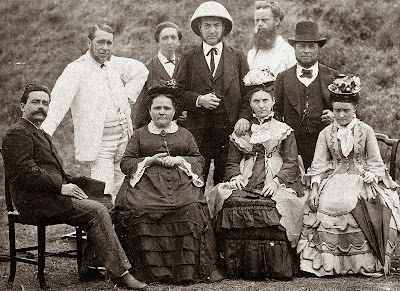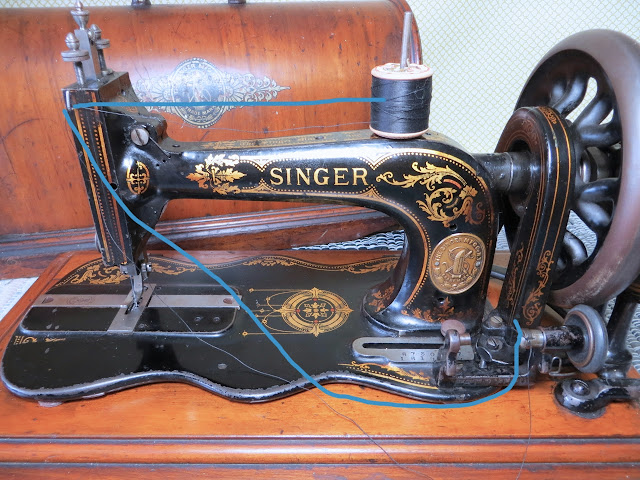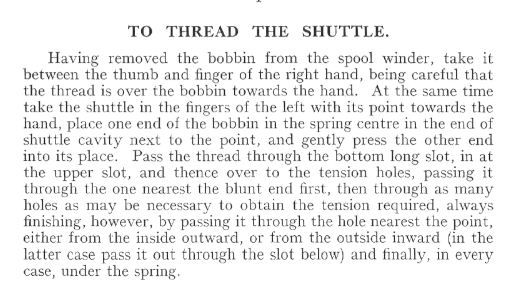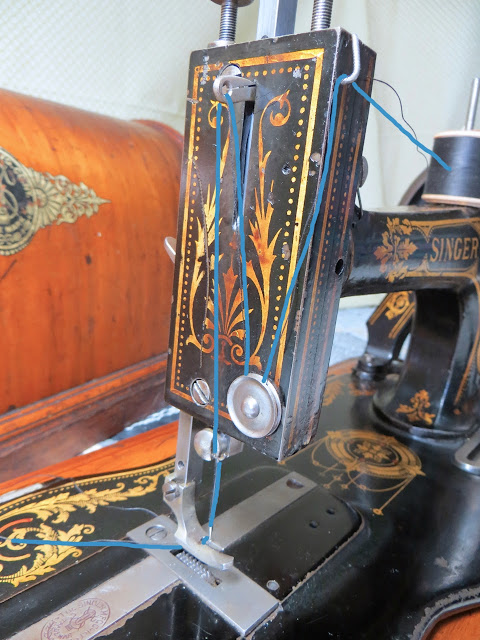I found this Singer 12 handcrank sewing machine from 1874 on Ebay and couldn’t resist buying a piece of history.
Do you know what 1874 looked like?
Here’s some pictures from that year.
This machine didn’t come with a manual, after all, it is 139-years-old! Can you believe that!?
I have a Singer 12K manual that is basically the same machine but a treadle. Download it here.
The machine has a really cool bentwood case.
It has a latch on the left-side that you can put a lock on. I find it interesting that most older machines have locks… you wouldn’t want anyone using your machine without permission!
I love the shape of the fiddlebase machines.. they look really cool!
The hand crank is the same idea as a treadle machine where you create the motion for the gears. It is a little harder to sew with compared to a treadle because you only have one hand for working with your fabric. The handle folds down to make room for the lid.
Top view.
Underside. Being able to lift up the machine makes cleaning and oiling a breeze as well as any maintenance.
One thing to be aware of is that these machines take different needles than the universal needles modern machines take. The are much longer and the shank is more narrow and completely round without a flat side. These are extremely rare if you’re looking for original needles, but if you want to buy reproductions I found a lady on Etsy who sells them.
It can be tricky inserting the needles in just the right spot because there isn’t a needle-stop and sometimes no clear markings of how far to insert the needle. The groove of the needle should be facing towards you – use trial/error to get the needle in just the right spot by sewing test runs. Once you get it in the right spot you can mark where you have it with a black sharpie on the needle bar.
The manual can be a little hard to follow along so I am including how-to’s for winding a bobbin, threading the shuttle and threading the top thread and fixing tension.
Engage your bobbin winder against the handwheel and tighten the set screw. With your thread set on the spool pin, bring the thread end around the hook at the front of the machine and over to the inside of the cup of the spooler.
Insert the end of your bobbin into the cup of the spooler with the thread in between – this will anchor the thread when you start winding.
While you crank with your right hand, hold your thread with the left and move it from side to side slowly as the bobbin fills. The manual says to build up the sides of the bobbin more with thread.
Hold the bobbin so the thread is coming from the backside to the bottom.
Insert it into the shuttle with the thread coming from underneath towards the small holes on the left side of the shuttle.
Take the end of the thread over the bobbin to the other side of the shuttle to the 2 long slots. Put it through the one on the bottom first and back through the top one back over towards the holes on the other side.
Put your thread through the first hole closest to the blunt end of the shuttle.
Put the thread through the last hole by the point…
…If you need a tighter tension go through more holes but make sure you always end on the last hole by the point, whether it’s exiting from the outside or inside.
Put the thread under the tension clip by threading it down.
Insert the shuttle into the machine.
You should be able to thread your machine just by this picture. Make sure to thread your needle from front to back.
You can clearly see from the loops on the underside of my fabric that the top tension is too loose.
Tighten it be twisting the tension screw (the bar closest to you) clockwise.
You can see the seam coming out of the machine is now perfect!















.jpg)


















20 Comments
Wow. It is a beautiful machine, but I sure am glad they progressed a little, especially in the bobbin area! I have a Singer 128 that uses a shuttle. Shakes like an earthquake. I love my 201 much much more, and now I'm eyeing a 401. Still, I'd have to have a big surplus on play money to ever go back to current machines. I love these vintage ones!
April 30, 2014 at 2:14 amThis is the most informative introduction to use of a transverse shuttle sewing machine on the NET.
January 27, 2015 at 12:26 pmThank you
Kennedy.Oxford .UK
Wonderful information just got one myself
September 28, 2015 at 2:29 pmyour site and your pictures show so much knowledge and love for vintage machines, I have the 12K treadle and am working to get it sewing. I did find needles and how to thread, but I really need a picture of the front with the cover off as I suspect the tension rod is not connecting correctly.
Paulette
February 5, 2016 at 4:03 pmThank you so much for putting up this very informative page. I'm no stranger to refurbishing old Singers but my junk shop find, a 12K in poor repair, was causing me issues. I was looking for a decent picture of the thread guide (4)and now I've found both it and the answer to several other questions. And the manual! I may never get it sewing well enough to actually use it for much but I'm now confident I can get it going at least a bit. Happy days!
September 14, 2016 at 1:42 pmI'm glad you're willing to give the old machine a shot at being fixed up! Good luck!
September 14, 2016 at 1:53 pmI found your blog simply by mistake. I have a Singer 1888 hand crank fiddle base. The manual was completely useless…Thank you so much for all the information and photos you added on this machine.
July 30, 2017 at 7:24 amIf I get lost I just go back to your instructions.
Thank you again.
Mary
Im glad to be of help! Thank you for your message!
July 30, 2017 at 7:27 amWhat a great informative video, it is hard to find out how to thread these old machines as nobody has kept the brochure/instruction booklet for 140 years. I have a machine identical to this underneath it has number 1783873 Manufacture 1874 but there is no brand name on the machine or the bentwood case! It has beautiful decals and I think it is probably one of the millions of European copies – nothing new in counterfeit goods!
August 26, 2017 at 12:24 pmI have to say that the bobbins that go in the boat shuttle are shorter than the bobbins that go in my 1892 Singer 28 (vibrating shuttle)? The modern reproduction lower bobbins do not fit this machine and I only have 6 of the original Victorian bobbins for this machine.
I used my 1874 machine yesterday to sew seatbelts for a bag I was making, I do not put thick seatbelts/leather ect through my electric sewing machines (Bernina 1230 (1990) or my Bernina (820 QE) 8 series (2014)). These old hand crank machines look beautiful and are brilliant for constructing thick bags and things like that.
It's so wonderful your 1874 machine is getting put to some use! I imagine it's seen a lot in it's long lifetime and prefers not to be left in a case 🙂
Thanks for the comment!
August 27, 2017 at 8:15 amVery helpful info on the Singer 12. Your machine is from 1885. The serial number closest to the pillar (6,730,497) is the one used to date the machine. The other number has something to do with where it was made.
January 31, 2018 at 8:38 pmExcellent information. Love that you posted LARGE & close-up pictures.
June 16, 2019 at 8:39 pmThank you!!
Thank you for the comment! 😀
June 16, 2019 at 10:56 pmThank you for your excellent pictures on threading the bobbin in the shuttle. I finally got an 1877 model 12, with the original cabinet, coffin lid and correct shuttle. It’s in fantastic condition for being 142 years old!
August 19, 2019 at 5:46 pmWow, sounds lovely!
September 5, 2019 at 12:04 pmHi, Love the machine. I have just bought a Fiddlebase Treadle. Am having trouble dating it. Can you help? The machine is the same as yours, but with the wrought iron treadle.
Thanks Eliza
January 12, 2020 at 8:38 pmHi Eliza! Congrats on your new machine! I don’t have any tricks of suggestions on dating your machine unfortunately. Sometimes you have to do a lot of poking around online to figure it out. Good luck!
January 13, 2020 at 6:00 amI recently purchased a 12k and cannot seem to find a shuttle for it. I think bobbins will be easier to find but since I don’t have parts list, I am not sure. Do you have any information on possible sources for these pieces?
March 20, 2020 at 8:23 pmYou article is exceptionally well done by the way. Many thanks!
Loved your article! I recently purchased a 12k and cannot seem to find a shuttle for it. I think bobbins will be easier to find but since I don’t have parts list, I am not sure. Do you have any information on possible sources for these pieces?
March 20, 2020 at 8:24 pmHi there! I don’t have any information except that the machine is similar to a Singer 12K – when I was doing research on it I believe I read that parts are interchangeable between the two machines. Singer 12K parts are more readily available I believe so try searching on Ebay. Good luck!
March 21, 2020 at 6:45 pm